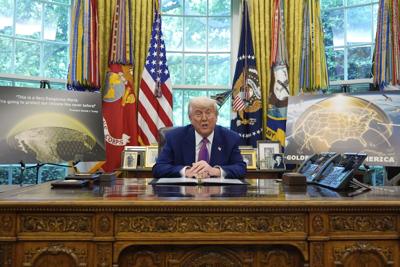OTTAWA ŌĆö Prime Minister Mark Carney’s office confirmed Tuesday that the federal government is in talks with U.S. President Donald Trump’s administration about participating in the multibillion-dollar American “Golden Dome” missile defence system.┬Ā
A spokesperson for Carney confirmed the two governments are in talks after Trump told reporters at the White House Tuesday that Canada wanted “protection” under what he billed as an advanced system designed to shoot down missiles aimed at North America.┬Ā
“Canadians gave the prime minister a strong mandate to negotiate a comprehensive new security and economic relationship with the United States,” read the statement from Carney spokesperson Audrey Champoux.┬Ā
“To that end, the prime minister and his ministers are having wide-ranging and constructive discussions with their American counterparts. These discussions naturally include strengthening (the North American Aerospace Defence Command [NORAD]) and related initiatives such as the Golden Dome.”┬Ā
Speaking earlier at the White House in Washington, D.C.,┬ĀTrump said the Canadian government has expressed interest in taking part in the system.┬Ā
“Canada has called us and they want to be a part of it. So we’ll be talking to them. They want to have protection also. So, as usual, we help Canada,” Trump said.┬Ā
Trump added that Canada will pay its “fair share” for the defence system, and suggested specifics would be discussed further.┬Ā
Trump told reporters the system would cost more than $243 billion and take three years to build, with systems on land, water and in space to shoot down missiles that are shot towards North America.┬ĀBilled as a “next generation” system to defend the United States, Trump said the Golden Dome will be able to intercept missiles launched from the other side of the globe, and “even if they are launched” from space.┬Ā
Donald Trump announces he's selected final 'Golden Dome' space missile defences that would cost billions. (AP Video / May 20, 2025)
The comments come as Carney has declared the previous relationship with the United States “over,” after Trump imposed tariffs on Canadian autos and goods like steel and aluminum. Since winning the April 28 election, his Liberal government has said it wants to negotiate a new security and commercial arrangement with the U.S. and develop stronger defence industry and economic partnerships with other countries.
- Tara Copp The Associated Press
Earlier this month, the U.S. Congressional Budget Office evolving threats have impacted the estimated cost to “deploy a constellation of space-based interceptors” designed to stop at least one intercontinental ballistic missile (ICBM). The office said such a system could cost between $224 billion and $785 billion to build and operate over 20 years.┬Ā
The office noted that Trump’s order to develop a Golden Dome missile defence shield is also meant to counter threats from “peer or near peer” military powers, like Russia and China, which would require a “much bigger” system to defend the U.S.┬Ā
Canada, meanwhile, has also identified Russia and China as security concerns, including in its ”Arctic foreign policy” published in December. Last year, when she took over command of the Canadian Armed Forces, Gen. Jennie Carignan said the military was tracking evolving capabilities in China and Russia “to reach us” in Canada, and working to “be ready to counter the threats that are coming.”┬Ā
The most recent official defence policy from the federal government included a pledge to┬Āmake “further commitments to the integrated air and missile defence” of North America. Bill Blair, the former ║ŻĮŪ╔ńŪ°╣┘═°police chief who was defence minister at the time, did not rule out working with the U.S. on defence against evolving threats like hypersonic missiles that travel faster and are harder to intercept.┬Ā
ŌĆ£It includes ballistic missile defence, but itŌĆÖs broader,ŌĆØ Blair said of the governmentŌĆÖs plan last April. ŌĆ£What weŌĆÖre seeing is the emergence of new technologies and new missile threats.ŌĆØ
In 2017, then-prime minister Justin Trudeau also expressed tentative openness to joining the U.S. missile defence system, at a time when North Korea was testing missiles that could reach parts of North America.┬Ā
More than a decade earlier, there was political debate and controversy over discussion about whether Canada should join the American ballistic missile defence system. Under Prime Minister Paul Martin, the federal government , leaving it to the U.S. to decide whether to shoot down any missiles fired over the continent.┬Ā
Since 1958, however, Canada has participated in the joint defence of North America with the U.S. through NORAD. In 2022, Ottawa committed $38.6-billion over 20 years to ”modernize” Canada’s contribution through the development of┬Ānew air navigation and communications systems, new long range missiles for planes, and other improvements.┬Ā
The plan also included a commitment to building new “over-the-horizon” radar systems. Earlier this year Prime Minister Mark Carney┬Āannounced a deal with Australia to spend more than $6 billion to develop to build such radar systems to detect threats like missiles in the Arctic.┬Ā
Carney has also promised to increase Canada’s defence spending, including in his visit to the White House on May 6. As a member of the North Atlantic Treaty Organization (NATO), Canada has pledged since 2014 to spend at least two per cent of its gross domestic product (GDP) on defence, but has never hit that threshold. Carney promised during this year’s election campaign to achieve it by 2030, two years faster than the time-frame Trudeau announced last year.┬Ā
Error! Sorry, there was an error processing your request.
There was a problem with the recaptcha. Please try again.
You may unsubscribe at any time. By signing up, you agree to our and . This site is protected by reCAPTCHA and the Google and apply.
Want more of the latest from us? Sign up for more at our newsletter page.































To join the conversation set a first and last name in your user profile.
Sign in or register for free to join the Conversation